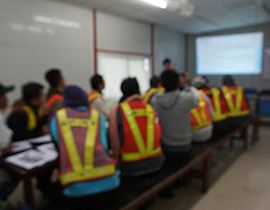services overview
What is an Arc Flash and what are the hazards? An Arc Flash is a rapid release of energy during an arcing fault between two electrical conductors. The fault is typically initiated by a dead short between the conductors, the cause of which generally burns away during the initial flash. The arcing fault is then sustained by the establishment of a highly conductive plasma, limited only by the impedance of the arc. This fiery explosion devastates everything in its path, violently discharging deadly shrapnel and molten metal. The core of an Arc Flash can reach temperatures as high as 35,000°F.
Injuries from an Arc Flash are among the leading causes of workplace fatalities. Thousands of workers are treated in specialized burn trauma centers each year as a result of Arc Flash injuries. Burns are not the only danger. The pressure wave from an Arc Flash can knock workers off ladders or platforms and even throw them across the room against walls or other hazardous equipment. The sound blast from an Arc Flash can cause eardrums to rupture resulting in temporary or permanent hearing loss. Even the bright flash from the event can cause temporary or permanent blindness. A high-level arc flash blast will most likely result in significant equipment damage and potentially personal injury or death.
services we offer

Arc Flash Analysis
As part of our comprehensive Arc Flash Hazard Assessment, we will ensure total compliance with all the latest NFPA 70E and OSHA requirements. We offer a complete turn-key solution for your Arc Flash project. Contact Endeavor Technologies, LLC now for your free Arc Flash analysis quote.
read more
Arc Flash Training
We offer Arc Flash training focused on the latest NFPA 70E requirements and how it relates to your facility’s electrical power system and your most valuable assets, your employees. See how we can help you and your employees with training in the latest standards and NFPA 70E requirements.
read moreArc Flash Analysis
Per OSHA Part 1910.132(d)(1), an employer is required to assess their workplace to determine if hazards are present, or are likely to be present, which necessitates the use of personal protective equipment (PPE). If so, the employer must select, and have each employee use, proper PPE to protect each affected employee from the hazards. OSHA also requires the employer to provide written certification of this risk assessment, identifying the workplace evaluated, the person certifying the evaluation, and the date.
Additionally, NFPA 70E-2018-130.5(H) states electrical equipment that is likely to require examination, adjustment, servicing, or maintenance while energized shall be field marked with a label containing the following: 1.) the incident energy, 2.) the system voltage, and 3.) the Arc Flash boundary. The Arc Flash boundary is defined in NFPA 70E-2018-130.5(E) as the distance at which the incident energy equals 1.2 cal/cm2. Therefore, this distance must be calculated for each piece of equipment.
What better way to ensure compliance with these and other requirements than to perform a comprehensive Arc Flash Hazard Assessment. Furthermore, should you choose not to do anything, OSHA can and has sited companies for a “willful act of negligence” not to comply with these requirements.
As part of our assessment, we will:
- Travel to your facility, open your equipment, and gather all required data without interruption to your facility's normal daily operations,
- enter this data into our power analysis software and perform a number of analyses including short circuit, arc flash, and device rating evaluation,
- generate a single line diagram of your facility's power system,
- generate and install Arc Flash warning labels on all required equipment,
- offer recommendations to reduce many of your facility’s higher ratings, to improve coordination, and to resolve other issues uncovered during the project,
- provide complete reporting and documentation that can be presented as proof of your facility’s compliance with the latest Arc Flash requirements,
- provide complimentary support for 12 months for minor revisions.
NFPA 70E Arc Flash Safety Training
Your personnel should know how to protect themselves and others from the dangers of Arc Flash and shock, and we at Endeavor take great pride in conveying this very specific message in a no nonsense, direct and most importantly, effective approach.
NFPA 70E Article 110.2 requires training for employees who are exposed to electrical hazards and for qualified persons to be familiar with the proper use of the special precautionary techniques, personal protective equipment including arc flash suit, insulating and shielding materials, and insulated tools and test equipment. Retraining is also required under certain circumstances and at intervals not to exceed 3 years.
Our training can be offered as a primary service or as a complement to our comprehensive Arc Flash assessment depending on your individual needs and your particular point of progress in implementing the latest NFPA 70E requirements.
Endeavor will bring NFPA 70E Arc Flash Safety Training to you. We will come to your facility and train your employees. Our on-site training allows your facility to keep its technical employees at your facility, thus minimizing lost employee man-hours that would otherwise be spent on travel.
In our Arc Flash training course, your employees will learn:
- The latest NFPA 70E requirements and how to implement them,
- The dangers of Arc Flash & shock hazards and how to recognize them and protect themselves from them,
- How to avoid, or at least minimize, the risk of personal exposure,
- Skills and techniques necessary to distinguish exposed energized parts,
- Skills and techniques necessary to determine the voltage of exposed energized parts,
- Additional techniques to use during Lock Out / Tag Out procedures,
- How changes to the power system can affect equipment Arc Flash ratings,
- Specific boundaries and safe approach distances,
- Proper PPE use and implementation.
